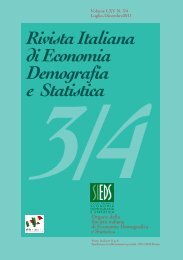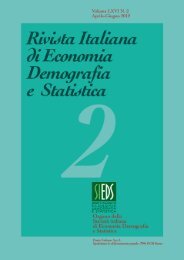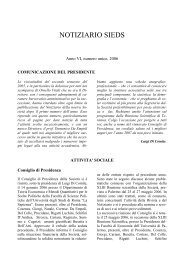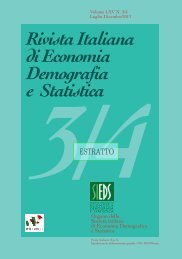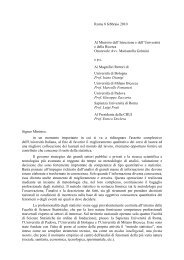rivista italiana di economia demografia e statistica - Sieds
rivista italiana di economia demografia e statistica - Sieds
rivista italiana di economia demografia e statistica - Sieds
You also want an ePaper? Increase the reach of your titles
YUMPU automatically turns print PDFs into web optimized ePapers that Google loves.
144<br />
Volume LXIII nn. 3-4 – Luglio-Dicembre 2009<br />
investire, attiene l’in<strong>di</strong>viduazione delle aree caratterizzate da un maggior livello <strong>di</strong><br />
povertà urbana, in modo da orientare la scelta del decisore pubblico in modo<br />
trasparente, argomentato ed oggettivo. I meto<strong>di</strong> utilizzati possono costituire,<br />
quin<strong>di</strong>, un utile supporto alle politiche abitative, evidenziando <strong>di</strong>fferenze territoriali<br />
altrimenti non emergenti con la stessa chiarezza. In conclusione, il modello qui<br />
sperimentato appare utile alla in<strong>di</strong>viduazione <strong>di</strong> quelle che l’Unione Europea<br />
definisce nell’ambito delle politiche regionali le aree bersaglio della rigenerazione<br />
urbana oggetto <strong>di</strong> appositi piani urbanistici e da sostenere con risorse economiche<br />
e finanziarie pubbliche e private.<br />
Riferimenti bibliografici<br />
Aldstadt J., Getis A. 2006. Using AMOEBA to create spatial weights matrix and identify<br />
spatial clusters. Geographical Analysis, 38, pagg. 327-343.<br />
Cerioli A., Zani S. 1990. A Fuzzy Approach to the Measurement of Poverty, Income and<br />
Wealth Distribution, inequality and Poverty (a cura <strong>di</strong> Dugum C., Zenga M.), Springer<br />
Verlag, Berlino.<br />
Cheli B., Lemmi A. 1995. A "Totally" Fuzzy and Relative Approach to the<br />
Multi<strong>di</strong>mensional Analysis of Poverty, Economic Notes.<br />
Fusco Girard L. (2006) The city between conflicts, contra<strong>di</strong>ctions and projects,<br />
Architecture City and environment, n.1 vol.1 pagg. 46-59.<br />
Kulldorff M. 1997. A spatial scan statistic. In: Statistics: Theory and Methods, n.26, pagg.<br />
1481-1496.<br />
Kulldorff, M., Nagarwalla, N. 1995. Spatial <strong>di</strong>sease clusters: detection and inference.<br />
Statistics in Me<strong>di</strong>cine, n.14, pagg. 799-810.<br />
Lemmi A., Pannuzi N. (1995) Fattori demografici della povertà, Continuità e <strong>di</strong>scontinuità<br />
nei processi demografici. L’Italia nella transizione demografica,4 Rubettino, Arcavacata <strong>di</strong><br />
Rende, pagg. 211-228.<br />
Montrone S., Perchinunno P., Rotondo F., Torre C. M., Di Giuro A. 2009. Identification of<br />
Hot Spots of Social and Housing Difficulty in Urban Areas: Scan Statistic for Housing<br />
Market and Urban Planning Policies. In: Murgante B., Borruso G., and Lapucci A. (eds.)<br />
Geocomputation and Urban Planning, Stu<strong>di</strong>es in Computational Intelligence, Vol. 176, pp.<br />
57–78, Springer Verlag Berlin Heidelberg.<br />
Montrone S., Bilancia M., Perchinunno P., Torre C.M. 2008. Scan Statistics for the<br />
localization of hot spots of urban poverty. Conference Procee<strong>di</strong>ngs of the Regional Stu<strong>di</strong>es<br />
Association - Winter Conference, Londra, pp. 74-77.<br />
Montrone S., Perchinunno P., Torre C. M. 2008. Zonizzazione <strong>di</strong> dati territoriali con una<br />
metodologia Scan statistics. In: Annali del Dipartimento <strong>di</strong> Scienze Statistiche “Carlo<br />
Cecchi”, Facoltà <strong>di</strong> Economia, Università degli Stu<strong>di</strong> <strong>di</strong> Bari, Cleup, Padova, vol. VII, pp.<br />
303-330.<br />
Openshaw S, Charlton M., Wymer C., Craft A.W. 1987. A mark I geographical analysis<br />
machine for the automated analysis of point data. International Journal of Geographical<br />
Information System, n.1, pagg. 335-358.



